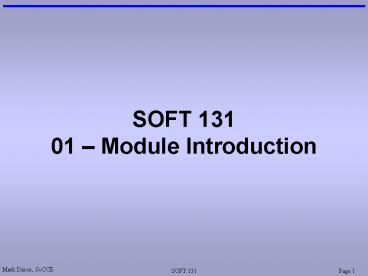SOFT 131 01 - PowerPoint PPT Presentation
1 / 29
Title: SOFT 131 01
1
SOFT 13101 Module Introduction
2
About Me
- Contact DetailsMark Dixonmark.dixon_at_plymouth.ac.
uk01752 232556Portland SquareRoom B316 - AvailabilityMon, Tue, Wed, Thu School of
Computing Communications and Electronics (main
campus)Fri other work (usually off-campus)
3
Module Aims
- This module aims to teach you, how to
- learn (self-directed)
- surface learning (memorisation of isolated
facts) hacking - deep learning (interrelated concepts)
- includes interacting with others (lecturers,
students, ) - develop software
- fundamental programming concepts (e.g. events,
procedures) - how to combine these to solve problems
- use Visual BASIC
4
Module Admin
- Lectures and tutorials
- start at 5 minutes past the hour, and
- aim to end at 5 minutes to the hour
- if no lecturer - wait until 15 minutes past the
hour then you may leave - Turn mobile phones off.
- Ask questions or comment at any time
- Feel free to talk quietly amongst yourselves
- Material (slides, handouts, etc.) available
before session, on Soft131 web-site
(mdixon.soc.plymouth.ac.uk) - Lectures
- Dont come in after 15 minutes past the hour.
5
Module Format
- The module is delivered as follows
- Lecture 1 hr per week, all groups, Mondays 1005
1055 - Tutorials / Practical Session 2 hr per
week Group 2 - Mondays 1505 1655 Group 1 -
Tuesdays 1105 1255 Group 3 - Tuesdays 1505
1655 (open to all) - Private study (as much as it takes typically 3
hours/week) - 1 to 1 sessions (my office or labs) as needed at
your request - Teaching Evaluation (timely and specific)
- Student Perception Questionnaire
- Continuous Informal Feedback (talk to me)
6
Schedule (subject to change)
7
Reading List 1
- The following book is recommended reading
- Deitel H, Deitel P (2006) Visual BASIC 2005 How
to program. Pearson Education Inc. ISBN
0-13-227958-4
8
Reading List 2
- Additional reading (the following are referred to
occasionally, borrow from library) - Pressman, R (2000) Software Engineering a
practitioner's approach. 5th edition.
McGraw-Hill. ISBN 0-07-709677-0. - Sommerville, I (2001) Software Engineering. 6th
edition. Addison-Wesley. ISBN 0-201-39815-X. - Overview of Software Engineering Chapter 1,
especially page 4. - Preece, J Rogers, Y Sharp, H Benyon, D
Holland, S and Carey, T (1994) Human-Computer
Interaction. Addison Wesley. ISBN 0-201-62769-8 - Direct Manipulation Section 13.6, pages 270-272.
- Interface Design Chapter 24, pages 487-499.
- Shneiderman, Ben (1998) Designing the user
interface strategies for effective
human-computer interaction. 3rd edition.
Addison-Wesley. ISBN 0-201-69497-2004.019 SHN
9
Student Background
- Typically wide range of prior experience
- 10 years programming (professional?)
- 5 years programming (professional?)
- 2 years programming (learning?)
- 1 year programming (learning)
- no programming
- Can be difficult to cater for all
number ofstudents
A B C D E
10
Attendance
- Attendance is compulsory and essential to pass
- This is not a distance learning course
- portal is supplement (not replacement) for
attending lectures and tutorials
11
Student Feedback
- feedback form
- filled in by students
- handed in with assignment
- this student
- failed (low attendance, low contact with me)
- did referred work (over summer)
- passed
12
Student feedback (zoom)
13
Last Year Results
- 56 students
- 19 failed initially (33)
- offered 1 to 1 sessionsafter assignment 1
- all who did this passed
- only 2 students failed retakes
14
(No Transcript)
15
HTML Elements Tags
- Hyper-Text Markup Language
- text files edited with notepad
- tags, e.g. ltbgt lthtmlgt lt/agt
- element start tag content end tag
- bold ltbgtThis will be in
boldlt/bgt - italic ltigtThis will be in
italiclt/igt - work like brackets
- start/open ltbgt ltigt
- end/close lt/bgt lt/igt
16
HTML page structure
- every HTML page has 2 sections
lthtmlgt ltheadgt lttitlegtTestlt/titlegt
lt/headgt ltbodygt ltpgtThis is a test
ltbgtpagelt/bgt. lt/bodygt lt/htmlgt
17
HTML Attributes
- Some tags need extra information to work
- Anchor (hyper-link) element lta
hrefnextpage.htmgtNext Pagelt/agt - Image element ltimg srcBeach.jpggt
- Embedded object element ltembed srcMusic.mp3gt
attribute (page to jump to)
attribute (filename of picture to display)
attribute (filename of music to play)
18
Example Intro page
lthtmlgt ltheadgt lttitlegtMark Dixon's web
sitelt/titlegt lt/headgt ltbody background"BackGro
und.JPG"gt ltfont size3gtltcentergtltbgtltpgt
Mark Dixon's web sitelt/bgtlt/centergt
ltfont size2gt ltpgtWelcome to my web
server. Please select from the following
list ltulgt ltligtlta
href"./Soft131/Index.htm"gt Soft131
Introduction to programming for
Multimedia and Internet applications.lt/agt
lt/ulgt lt/fontgt lt/bodygt lt/htmlgt
19
HTML Tags Reference
- Lots of info available on-line, e.g.
- http//www.willcam.com/cmat/html/crossref.html
- Short list of tags
- ltpgt new paragraph
- ltbgt bold text
- ltigt italic text
- ltagt anchor (link) to another web page
- ltimggt image/picture (.bmp, .jpg, .gif)
- ltembedgt embedded object (sound .wav, .mp3)
20
Visual Studio 2005
21
Create New Web-site
- Select Empty web site
- Browse to D\ and create folder
22
Create New Web page
23
Create New Web Page
- Select HTML Page
- Type filename
24
Visual Studio
Design view see page as it will appear
25
Visual Studio
Source view see HTML code
26
View page (Run)
27
Enable debugging
- Select Add new Web.config file
28
Example My Summer
My summer web-page
29
Tutorial Exercise 1 My Summer
- LEARNING OBJECTIVE to understand tags,
elements, and attributes, so that you can
create your own web-pages using a simple
text editor (e.g. notepad) - TASK Create a My Summer web page, which
describes the highlights of what you did over the
summer, including text, pictures, and sound.































